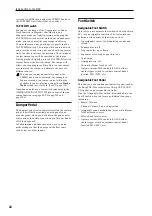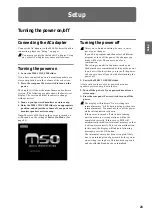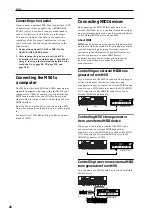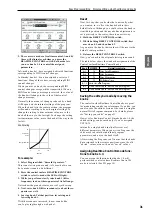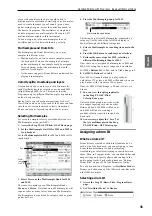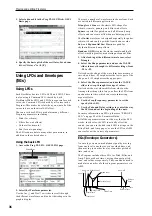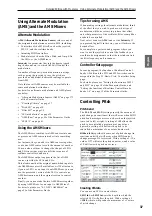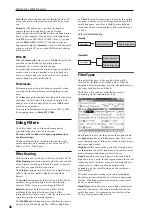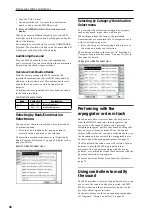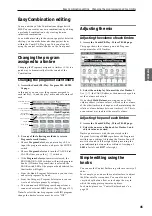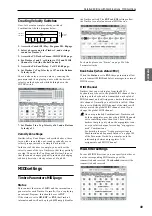
Playing and editing Programs
34
Detailed Editing with Programs
Creating your own Programs
You can create original sounds by editing a preloaded
program or by editing an initialized program. The
programs you create can be saved in banks A–E.
For details, please see “Saving your edits” on page 33.
About the edit pages
In the Prog P0: Play page you can select and play
programs. Here, you can also use the control surface’s
knobs and the tone adjust function to perform quick
editing, or edit the settings of the arpeggiator or drum
track. In the other pages described here, you can edit
the sound in greater detail.
For details on each mode and how to access each page,
please see “Basic operations” on page 16.
Basic oscillator settings
Program type setting (single, double,
drum kit)
Here, You can specify the type of program (whether to
use one oscillator, two oscillators, or a drum kit). Use
the Prog P1: Basic/Ctrls– Program Basic Oscillator
Mode
to specify the program type.
Single
Programs have one oscillator, and Double
Programs have two oscillators. Each oscillator is a
multisample that is switched by a crossfade velocity
switch. You can use dual filters, EG, and LFO to create
the sound.
Drums
mode is a special variation of Single mode, and
uses a Drum Kit (as created in Global mode) instead of
Multisamples.
Polyphony
Polyphony is the number of notes that can be played
simultaneously, such as in a chord. The polyphony
depends on the program type.
Note:
• Double Programs use twice as many voices as
Single Programs.
• Stereo Multisamples use twice as many voices as
Mono Multisamples.
• If using velocity crossfade switching, the
multisample will use twice as many voices as usual.
Polyphonic/monophonic playing
The Voice Assign Mode selects whether the Program
will play polyphonically (Poly) or monophonically
(Mono).
When this is set to Poly, you can play both chords and
melody lines. When this is set to Mono, only one note
will sound even if you play a chord.
Normally you’ll set this to Poly, but Mono is useful
when playing sounds such as synth basses, synth
leads, and other solo instruments.
Try switching between Poly and Mono, and listen to
the results.
Working with Multisamples
What is a multisample?
A sample is a digital recording of a particular
instrument or waveform (or other natural or artificially
Program type
Polyphony
Single
80
Double
40
Drums
80
OSC1 Basic: P2–1
Amp1/Driver1: P4–1
Pitch EG : P2–8
Filter1 EG: P3–1–5
Amp1 EG: P4–3
OSC1 LFO1: P5–1
OSC 1
OSC 2
Filter1 Mod: P3–1–3
Filter Key Track: P3–1–2
Filter1 LFO Mod: P3–1–4
OSC1 Pitch: P2–2
OSC1 LFO2: P5–2
Amp1 Mod: P4–2
Program Basic: P1–1
AUDIO OUTPUT
L/MONO, R
Master
Effect
1, 2: P9
Total
Effect
: P9
Insert
Effect
1…5: P8
Oscillator / Pitch
Filter
Amplifier
Effects
3Band EQ
: P4–8
Filter1(A/B): P3–1–1
OSC1 AMS Mix: P6–1/2
Common KeyTrack: P6–7/8
OSC1, 2
Insert Effects
Master Effects
FX Control Bus
Routing: P8–1
EQ
Common LFO: P5–8
Chord Trigger Switches: P1–8
Arpeggio: P7–1, 2
DrumTrk Prog: P7–4, 5
Tone Adjust: P0–7
Controllers: P1–7
P1–1, P2–2, etc. indicate the on-screen pages and tabs used when editing on the M50.
Summary of Contents for EASYSTART M50
Page 1: ...3 E Owner s Manual ...
Page 84: ...Arpeggiator function 78 ...
Page 88: ...Drum Track function 82 ...



